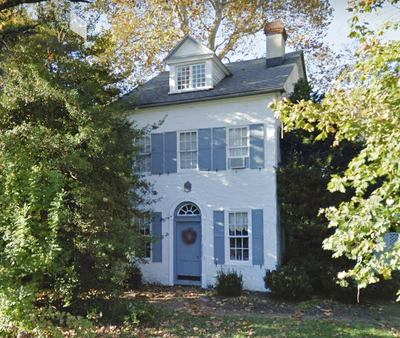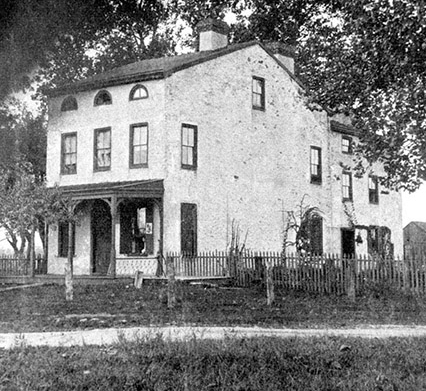Blue Ball Inn

The former Blue Ball Inn in Daylesford on the Old Lancaster Road in Chester County is now a private residence, but its history is well-known to lovers of ghost stories. And for good reason.
The Blue Ball tavern was first established near the Lancaster Pike about 1735. There were numerous owners before Bernhard Van Leer purchased the property in 1759. When Van Leer died in 1790, the property passed to his daughter Mary, wife of Moses Moore. Soon after they took over the Inn, the new turnpike cut off access to the Inn. The Moores then constructed a new tavern north of the turnpike.
In 1831, this new tavern became the property of Priscilla, daughter of Moses and Mary Moore. By then, Prissy, as she was known, was on her second (or possibly third) husband, James Cahill. Her first marriage was on June 30, 1806 to Edward Robinson. Supposedly she also married a man named John Fisher at some point but I can not find any details at all about him. All three husbands supposedly disappeared mysteriously. So did a lot of other people who visited the inn during Prissy’s time.
People told strange stories of the Blue Ball and its landlord, Prissy Robinson. Muffled cries and scraping noises disturbed the sleep of the inn’s guests, but in the morning Prissy would be there serving up hot coffee and doughnuts, apparently without a care in the world. It seemed that the wealthier a patron was, the more likely they were to disappear during the night. Prissy would shrug and say they must have taken off during the night.

Her temper was legendary and most often directed at the railroad that threatened her inn’s business. When a passing train killed one of her heifers, Prissy demanded that the railroad pay her for the damage. Not receiving satisfaction from the railroad, Prissy took matters in her own hands. She rendered the fat from the slain bovine and smeared the tallow on the tracks on the incline near her inn. The slick tallow proved too much for the locomotives as they kept sliding back. By the end of the day, Prissy got her money from the railroad. She had another reason for hating the railroad.
Fire on the Columbia Railroad. This railway, the Philadelphia and Columbia Railroad became part of the Pennsylvania Rail Road in 1857. A gentleman called in our office last evening, and informed us that sparks from one of the locomotives on this road, communicated to a two story house, belonging to a widow lady named Priscilla Cahill, about 17 miles from this city, which was burnt to the ground. This accident occurred about ten o’clock yesterday morning. 1Public Ledger, 4/9/1836
When the Blue Ball Inn was first constructed about 1790, there were only two stories. After a fire damaged the building, the owner added the third story with its half-circle windows. Perhaps the fire in 1836 was the one that inspired the change in the structure.
The Blue Ball Inn probably didn’t need any more bad news to sully its reputation, but you can’t always get what you want. In the case of the Inn, one set of owners got a real surprise during some work on their newly acquired home.
Six Skeletons in Blue Ball2Pittsburgh Press, 1/4/1902
Bad Reputation of Ancient Tavern Borne Out by Gruesome Finds
Philadelphia, January 4 – Six un-coffined skeletons have been found buried in the cellar of the Old Blue Bell Inn, at Dalesford, Pa. The tavern is an ancient landmark and for years has borne an unsavory reputation.
Joseph B. Croasdale, a lawyer, is the present owner. He was making some improvements on the property when the skeletons were unearthed. IN speaking of the find, his representative, Olney Croasdale, said today:
The trouble began when my cousin started to transform the old inn into a country residence. The house was haunted, everyone, excepting ourselves, said so. We could keep no servants because of the cries and strange noises which alarmed them, they declared, at night. The climax, which converted us into a belief that the tavern deserved its unsavory reputation, came when, in digging on the property to lay the foundation of a summer house, and while excavating in the cellar of the inn itself, we discovered six skeletons that had evidently been hidden away hastily. These human structures were complete, though some showed broken bones or cleft skulls.”
“These bones indicate beyond a doubt that somebody had a private graveyard on the premises. Prissy Robinson was the last landlady of the inn. I have not a doubt that if further excavations were made more human bones would be found. We dug a grave and gave the bones a decent burial. It is certainly an interesting questions as to how many persons were done away with at the inn during the 50 years from 1809 to 1860. Local stories and traditions place the number very high.”Prissy belongs to my family tree, though, thankfully, at a distance.
